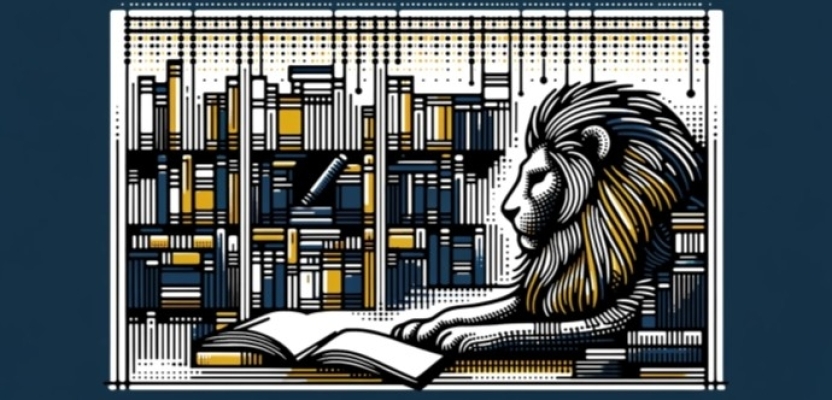
Sticky, sweet, and golden in colour, Lyle’s Golden Syrup has been used in home-baking since 1883, and the green and gold tin is a common sight in British kitchens. However, anybody who has taken a close look at the tin will likely have been intrigued by the logo: an image of a dead lion, surrounded by a swarm of bees.
Sam Gruet at the BBC writes:
'Lyle’s well-known Victorian-style tins were first introduced by Scottish businessman Abram Lyle more than 150 years ago, the same year as the first electric railway.
According to the company’s website, Lyle had strong religious views, which is why the logo depicts the story of Samson from the Old Testament, in which Samson killed an attacking lion, and later noticed a swarm of bees had formed a comb of honey in the carcass.
He later turned this into a riddle: “Out of the eater came forth meat and out of the strong came forth sweetness.”
The second half of the quote was used on the original branding of Lyle’s Golden Syrup.'
In fact, Lyle’s Golden Syrup holds the world record for the world’s oldest unchanged brand packaging. Last month, however, the company updated the packaging design for the first time in a longtime.
'The image of a dead lion being swarmed by bees is to be dropped from some of Lyle’s Golden Syrup packaging.
A rebranded image of a lion’s head with a single bee will feature on products, including the firm’s plastic syrup and dessert bottles.
But the classic Lyle’s Golden Syrup tin will be excluded from the rebrand, keeping its more than 150-year-old packaging design.
The company said it was to refresh its appeal to modern shoppers.'
Helen Edward, of London Business School, told the BBC: ‘The story of it coming from religious belief could put the brand in an exclusionary space, especially if it was to go viral on X or TikTok.’ (Samson, an Abrahamic figure, has a place in Christian, Jewish, and Muslim literature – though Abram Lyle himself was a Christian.) Helen Edward went on to say:
'But hanging on to some of the original branding is a good idea as people tend to remember brands through visual codes – the green colour, the lion – which remind people ‘that’s the product I buy, that’s the one I like’.'
Despite maintaining some of the packaging’s original elements, Lyle’s partial rebrand has been controversial. A direct descendant of Abram Lyle’s even shared that he ‘felt the loss’ of his great-great-great-grandfather’s tin, and Creative Review called the ordeal ‘a rather sticky mess’. The article, by Megan Williams, says:
'Creatives have leveraged the argument that the new design is neither modern nor retains any of its heritage, and as a result falls into a middle ground that makes it entirely forgettable.'

Stripped of its former vintage charm, the lion now looks slightly saccharine, and the bottle does not stand out on the shelf. It may be hard to pinpoint exactly why this new packaging has been so poorly received, but we might be able to better understand the backlash when we start to think about culture.
Sherzad Rahmatian, writing for The Next Web, explored this topic in an article called ‘Why brands actually benefit from staying true to their cultural roots’:
'[C]onsumers are increasingly pushing back against homogeneity and yearning for a return to communities, spaces, and subcultures that reflect their uniqueness. Demonstrating this point — a 2022 survey revealed that 68% of consumers feel more positively about brands demonstrating cultural knowledge, while another 2023 report showed businesses that used cultural data in their marketing strategy saw a 19% increase in engagement.'
Here are some things that Rahmatian suggests companies should do, in order to preserve the culture of their brand:
'Culture is formed around a shared physical (or proverbial) place, whether that be a city, cuisine, language, or myth.'
1. Anchor through an authentic sense of place or space
Rahmatian uses the example of tech companies:
'While the majority of tech companies are inherently placeless, they can still represent an idea, story or set of values through product, service or brand experience. For example, Apple has infamised “designed in California” as an homage not only to its headquarters but also to its design ethos, proving that tech brands can also ground in a sense of place.'
In the case of Lyle’s Golden Syrup, the original packaging brings Victorian England to mind, whereas the new packaging is more ambiguous – in line with the company’s ambition to appear more inclusive – but, perhaps, at the cost of suppressing some of the brand’s cultural heritage.
2. Tap into the subcultures that transcend physical borders
'If the 20th century’s greatest brands exported the mass culture of a place, the 21st century’s might be rooted in more niche subcultures that can be formed anytime and anywhere, much like tech companies.'
Lyle’s rebrand falls in between these two categories: it no longer overtly represents Britain, but doesn’t feel different enough to reach new and niche audiences either. In trying to strike a balance between authenticity and neutrality, the new packaging gets lost.
3. Re-centre the voice of the consumer
'Ultimately, cultures require people to generate, nurture, and protect them. Rather than seeking to own, arbitrate, and express culture themselves, brands can set egos aside, re-centering and elevating the voices of the people who are at the centre of the cultures themselves – their own consumers.'
It makes sense that, in a bid to try and appeal to a more modern consumer-base, Lyle’s decided that it was time to change their 150-year-old packaging. However, this has left a significant portion of their loyal audience feeling disappointed. Rather than nurturing an existing audience, Lyle’s has sought to reach new customers – and it is yet to be seen whether this will pay off in the long term.
While taking a deep dive into Lyle’s partial rebrand is interesting, we are well aware that each brand – and each brand culture – should be unquestionably unique. When working with clients on a branding or rebranding project, we’ll always consider the target audiences first, making sure we deliver desired results. As we’ve previously discussed on this blog, storytelling is an important part of branding – but it’s also an important part of cultural heritage.
'If stories build culture, and culture is an important element of your brand – it’s important that you’re telling the right story.'
During a seminar at the Long Now Foundation, writer Neil Gaiman spoke about how stories last. Gaiman began by talking about emperors and kings whose names or resting places have been forgotten – yet details of their lives are immortalised through story. He went on to say that stories are alive: they have the capacity to grow, reproduce, and change. In fact, the oldest stories are thousands of years older than even the oldest tree in the world, which is 5,064. Memorable and interesting details – such as Cinderella’s glass slippers – are the elements that keep stories alive.
'If stories do not change – they die. They need to be told and re-told: shifted and adapted to remain memorable.'
Every story begins with an act of imagination, but stories contain useful information, so they need to come in a memorable form. Gaiman says that a story is more likely to survive, if it has ‘things that are sweet around it, things that make it fun to pass on, that make it pleasurable to tell.’
This is especially important for companies that are trying to define their brand story. Gaiman highlights the fact that people are one of the places that stories can be stored – oral storytelling is one of humanity’s oldest traditions. From a branding perspective, oral storytelling can take the form of brand evangelism. If your brand story is memorable, interesting, and also contains relevant information about your brand – people may be more likely to share it.
Gaiman says that books are like sharks: they’ve survived so long because nothing better has come along to replace them. This is also true in the world of business – if your company is the best at what it does, make sure your branding tells that story.




